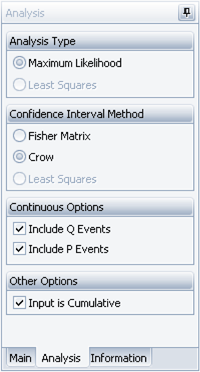Template:Event codes crow rga
Jump to navigation
Jump to search
Event Codes
The Crow Extended - Continuous Evaluation model uses a column to indicate the events that occurred during testing. Within RGA, event codes are entered within the Event column of the Multi-Phase data sheets. The possible event codes that can be used in the analysis are:
- • F: indicates a failure time.
- • I: denotes that a fix has been implemented for a BD failure mode at the specific time [math]\displaystyle{ . }[/math] BD modes that have not received a corrective action by time [math]\displaystyle{ T }[/math] would not have an associated I event in the data set.
- • Q: indicates that the failure was due to a quality issue. An example of this might be a failure caused by a bolt not being tightened down properly. You have the option to decide whether or not to include quality issues in the analysis. This option can be specified by checking or clearing the Include Q Events checkbox under Continuous Options on the Analysis tab, as shown in Figure Q-event options.
- • P: indicates that the failure was due to a performance issue. You can determine whether or not to include performance issues in the analysis. This option can be specified by checking or clearing the Include P Events checkbox under Continuous Options on the Analysis tab, as shown in Figure Q-event options.
- • AP: indicates an analysis point. Analysis points can be shown in a multi-phase plot to track overall project progress and can be compared to an idealized growth curve.
- • PH: indicates the end of a test phase. Test phases can be shown in a multi-phase plot to track overall project progress and can be compared to planned growth phases. RGA 7 allows for a maximum of seven test phases to be defined.
- • X: indicates that the data point will be excluded from the analysis. An "X" can be placed in front of any existing event code or entered by itself. This row of data will then not be included in the analysis.
Figure Folioxample shows an example of a Crow Extended - Continuous Evaluation folio with all of the possible event codes. As you can see, each failure is indicated with A, BC or BD in the Classification column. In addition, any text can be used to specify the mode. In this figure, failure codes were used in the Mode column for simplicity, but you could just as easily use Seal Leak, or whatever designation you deem appropriate for the failure mode.

